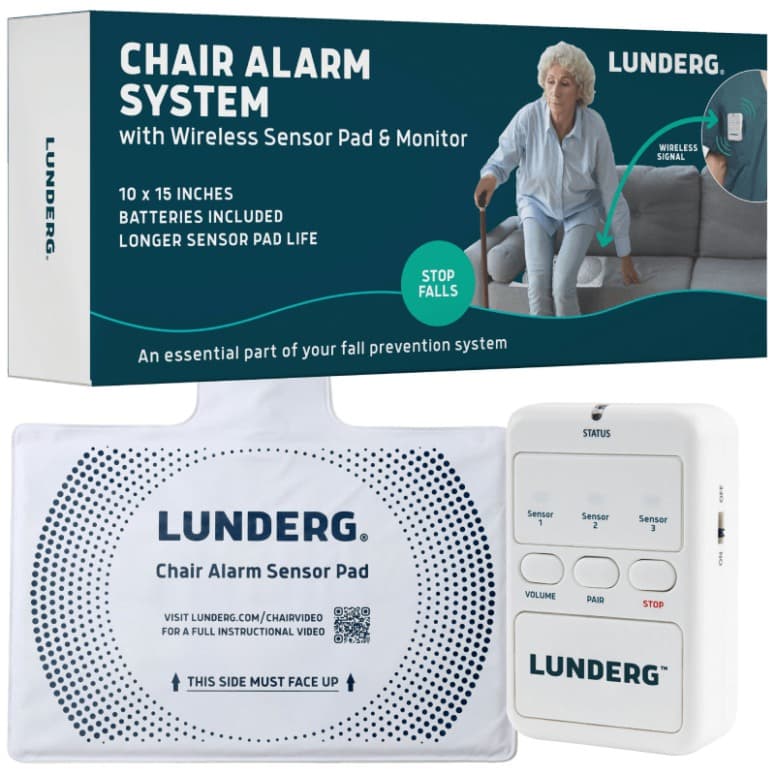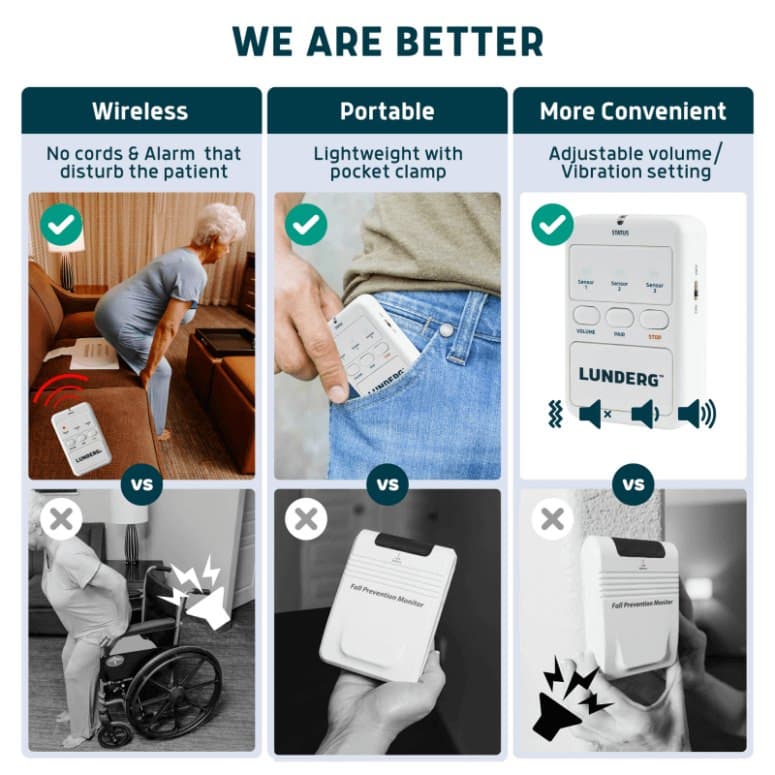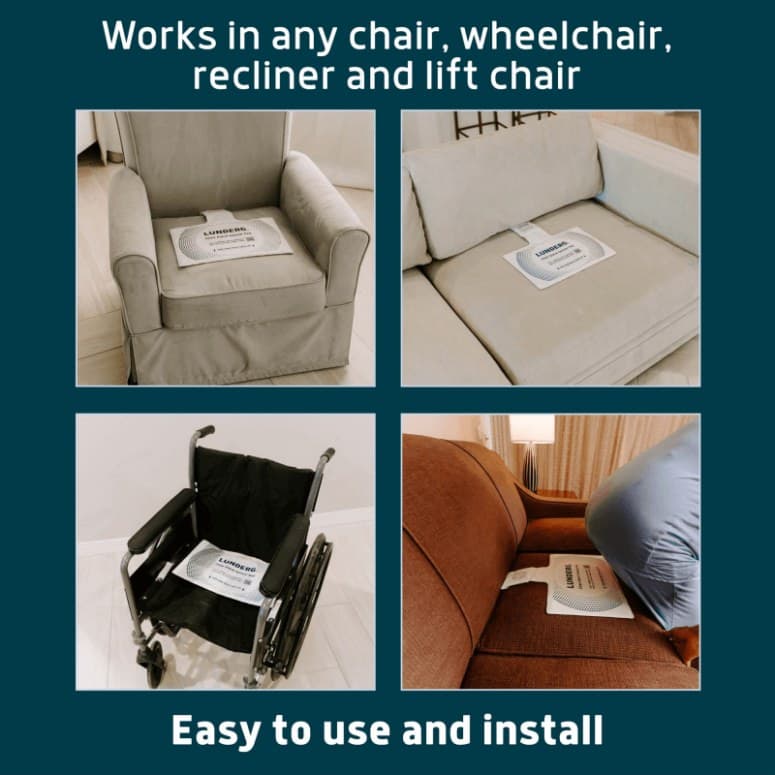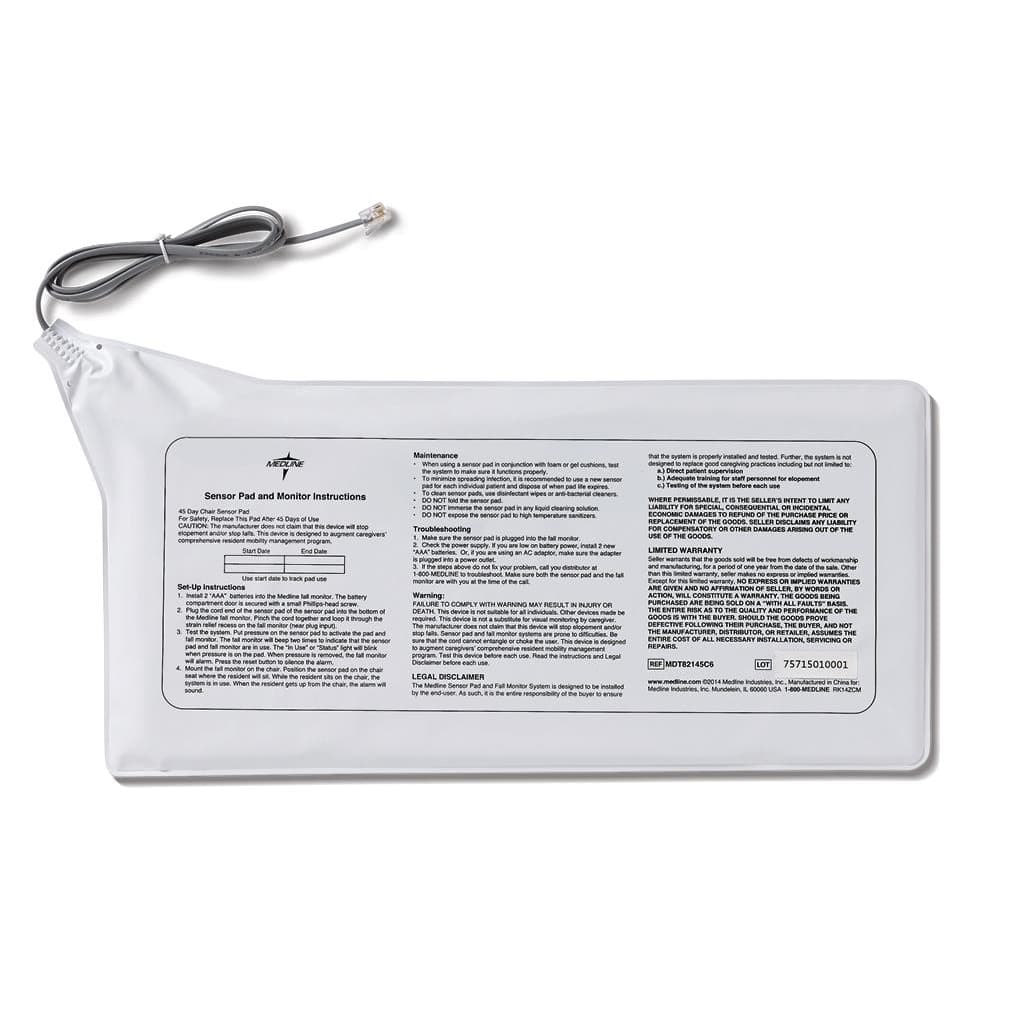




Lunderg Chair Alarm System with Wireless Sensor Pad and Monitor
Earn Loyalty Points
+110Buy more to unlock extra rewards!
PayPal Pay Later
Free Shipping
Description
Lunderg Chair Alarm System with Wireless Sensor Pad and Monitor is a great solution for monitoring elders or patients who are at risk of falling. This wireless smart chair alarm sensor pad and pager are specifically designed to alert you the moment your loved one rises from their chair to prevent fall. It can be used in a wheelchair, recliner, sofa or even a lift chair.
The Lunderg Fall Prevention Chair Alarm System connects wirelessly with a pocket-sized handheld monitor emitting a continuous alarm or vibration when the patient stands. It has option to adjust the volume according to your preference, choosing from high to low or opting for a vibration-only mode as per user needs and its patented technology reduces the risk of False Alarm.
Features of Wireless Chair Alarm System by Lunderg:
- 10 x 15 inches pressure pad is easy to clean and resistant to incontinence
- Includes all batteries for ready to use and easy installation
- Wireless connectivity of sensor pad to handheld monitor
- Mount Bracket provides option to attach monitor to wall
- Volume adjustment option with vibration only mode
- Patented technology to reduce false alarm
- Unique compact portable pager to fit in pocket with handy pocket clip
Warranty
- Manufacturer provides 1 Year limited warranty against manufacturing defects from the date of purchase.
- Parts under warranty will be covered at no cost.
- Any labor cost for service under warranty is not covered as per our terms of sale.
- Standard manufacturer terms & conditions apply for warranty of this product.
Please call us for Specific Details.
Return
- We gladly accept returns within 30 days from the date of shipment for a full refund. Unfortunately, we are unable to process returns beyond this timeframe.
- To ensure a smooth return process, all items must be returned in their original condition and packaging.
- A Returned Goods Authorization (RGA) number is required before sending back any item. This helps us process your return efficiently.
- Items must be new, unused, and untampered to qualify for a refund. Customers are responsible for return shipping costs.
- If a return is not due to a manufacturing defect, any applicable payment processing fees (credit card/PayPal) will be deducted from the refund.
- This product is subject to the standard return policy set by the manufacturer.
If you have any questions or need assistance with your return, our team is happy to help. Please contact us for further details.
FAQs
Q. How does the Lunderg Chair Alarm System help prevent falls?
A. It wirelessly alerts caregivers as soon as the user starts to stand
up, allowing for quick assistance.
Q. Can this chair alarm be used on different types of chairs?
A. Yes, it works with wheelchairs, recliners, sofas, and even lift
chairs.
Q. Does the alarm make a loud noise?
A. The volume is adjustable, with options ranging from high to low, or
you can choose a vibration-only mode.
Q. How does the system prevent false alarms?
A. It uses patented technology that reduces the likelihood of false
triggers, ensuring reliable alerts.
Q. Is the sensor pad easy to clean?
A. Yes, the sensor pad is wipeable and resistant to incontinence.
Q. How does the monitor connect to the sensor pad?
A. The pad connects wirelessly to a pocket-sized handheld monitor for
convenient use.
Q. Can I mount the monitor on the wall?
A. Yes, it includes a mounting bracket for easy wall attachment if
needed.
Q. Does the system come with batteries?
A. Yes, all required batteries are included, making it ready to use
out of the box.
Q. How portable is the handheld monitor?
A. It is compact, lightweight, and comes with a pocket clip for easy
carrying.
Q. Is this chair alarm suitable for home and professional use?
A. Absolutely! It’s ideal for both home caregivers and healthcare
facilities.
Q. How far can the alarm system transmit signals?
A. In open areas, the system covers up to 400 feet (122 meters). Indoors,
signal strength may vary—wood and drywall allow better transmission, while
concrete, brick, or metal can weaken or block it. It's best to test the system
in your actual environment.
Q. What’s the proper way to place the sensor pads?
A. Placement depends on the type of pad. Chair pads rest directly on seating surfaces like sofas, recliners, or standard
chairs.
Q. Is it possible to use multiple devices with one pager?
A. Yes, a single pager can connect with up to three compatible devices at
once—such as bed and chair pads or alert buttons—making it a flexible solution
for monitoring multiple sources.
Q. How long do the batteries last?
A. The pager uses 2 AA non-rechargeable batteries, but if you desire you can
switch to rechargeable ones, so you can re-use them. Battery lifespan depends on
usage and range. Sensor pads have a built-in non-rechargeable battery lasting
about 15 months—after that, the pad should be replaced for safety.
Resources
Description
Lunderg Chair Alarm System with Wireless Sensor Pad and Monitor is a great solution for monitoring elders or patients who are at risk of falling. This wireless smart chair alarm sensor pad and pager are specifically designed to alert you the moment your loved one rises from their chair to prevent fall. It can be used in a wheelchair, recliner, sofa or even a lift chair.
The Lunderg Fall Prevention Chair Alarm System connects wirelessly with a pocket-sized handheld monitor emitting a continuous alarm or vibration when the patient stands. It has option to adjust the volume according to your preference, choosing from high to low or opting for a vibration-only mode as per user needs and its patented technology reduces the risk of False Alarm.
Features of Wireless Chair Alarm System by Lunderg:
- 10 x 15 inches pressure pad is easy to clean and resistant to incontinence
- Includes all batteries for ready to use and easy installation
- Wireless connectivity of sensor pad to handheld monitor
- Mount Bracket provides option to attach monitor to wall
- Volume adjustment option with vibration only mode
- Patented technology to reduce false alarm
- Unique compact portable pager to fit in pocket with handy pocket clip
Warranty
- Manufacturer provides 1 Year limited warranty against manufacturing defects from the date of purchase.
- Parts under warranty will be covered at no cost.
- Any labor cost for service under warranty is not covered as per our terms of sale.
- Standard manufacturer terms & conditions apply for warranty of this product.
Please call us for Specific Details.
Return
- We gladly accept returns within 30 days from the date of shipment for a full refund. Unfortunately, we are unable to process returns beyond this timeframe.
- To ensure a smooth return process, all items must be returned in their original condition and packaging.
- A Returned Goods Authorization (RGA) number is required before sending back any item. This helps us process your return efficiently.
- Items must be new, unused, and untampered to qualify for a refund. Customers are responsible for return shipping costs.
- If a return is not due to a manufacturing defect, any applicable payment processing fees (credit card/PayPal) will be deducted from the refund.
- This product is subject to the standard return policy set by the manufacturer.
If you have any questions or need assistance with your return, our team is happy to help. Please contact us for further details.
FAQs
Q. How does the Lunderg Chair Alarm System help prevent falls?
A. It wirelessly alerts caregivers as soon as the user starts to stand
up, allowing for quick assistance.
Q. Can this chair alarm be used on different types of chairs?
A. Yes, it works with wheelchairs, recliners, sofas, and even lift
chairs.
Q. Does the alarm make a loud noise?
A. The volume is adjustable, with options ranging from high to low, or
you can choose a vibration-only mode.
Q. How does the system prevent false alarms?
A. It uses patented technology that reduces the likelihood of false
triggers, ensuring reliable alerts.
Q. Is the sensor pad easy to clean?
A. Yes, the sensor pad is wipeable and resistant to incontinence.
Q. How does the monitor connect to the sensor pad?
A. The pad connects wirelessly to a pocket-sized handheld monitor for
convenient use.
Q. Can I mount the monitor on the wall?
A. Yes, it includes a mounting bracket for easy wall attachment if
needed.
Q. Does the system come with batteries?
A. Yes, all required batteries are included, making it ready to use
out of the box.
Q. How portable is the handheld monitor?
A. It is compact, lightweight, and comes with a pocket clip for easy
carrying.
Q. Is this chair alarm suitable for home and professional use?
A. Absolutely! It’s ideal for both home caregivers and healthcare
facilities.
Q. How far can the alarm system transmit signals?
A. In open areas, the system covers up to 400 feet (122 meters). Indoors,
signal strength may vary—wood and drywall allow better transmission, while
concrete, brick, or metal can weaken or block it. It's best to test the system
in your actual environment.
Q. What’s the proper way to place the sensor pads?
A. Placement depends on the type of pad. Chair pads rest directly on seating surfaces like sofas, recliners, or standard
chairs.
Q. Is it possible to use multiple devices with one pager?
A. Yes, a single pager can connect with up to three compatible devices at
once—such as bed and chair pads or alert buttons—making it a flexible solution
for monitoring multiple sources.
Q. How long do the batteries last?
A. The pager uses 2 AA non-rechargeable batteries, but if you desire you can
switch to rechargeable ones, so you can re-use them. Battery lifespan depends on
usage and range. Sensor pads have a built-in non-rechargeable battery lasting
about 15 months—after that, the pad should be replaced for safety.












